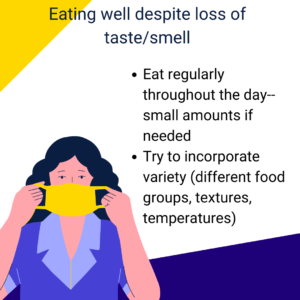 Have you ever eaten something so quickly you barely tasted it? Or ate while you were driving/watching TV and missed out on tasting and enjoying your food? Taste is one of our five senses, and I have really learned not to take this one for granted. When I had covid-19 several months ago, I lost my taste and smell completely for ten days. It was different than past experiences where I had a cold and couldn’t taste well—it was entirely gone. I will admit, this affected my mind big time! I felt hungry, but often had trouble deciding what to eat. I never felt entirely satisfied after eating (even if I was physically full—satisfaction from our food comes from a variety of factors!) A few months later, I have regained some of my smell and taste back, but my taste is still significantly affected. I am so thankful to be able to at least taste some foods now, and every time I eat I remind myself to really try to taste the food (as best as I can for the time being. 😊)
Have you ever eaten something so quickly you barely tasted it? Or ate while you were driving/watching TV and missed out on tasting and enjoying your food? Taste is one of our five senses, and I have really learned not to take this one for granted. When I had covid-19 several months ago, I lost my taste and smell completely for ten days. It was different than past experiences where I had a cold and couldn’t taste well—it was entirely gone. I will admit, this affected my mind big time! I felt hungry, but often had trouble deciding what to eat. I never felt entirely satisfied after eating (even if I was physically full—satisfaction from our food comes from a variety of factors!) A few months later, I have regained some of my smell and taste back, but my taste is still significantly affected. I am so thankful to be able to at least taste some foods now, and every time I eat I remind myself to really try to taste the food (as best as I can for the time being. 😊)
I have always encouraged clients to eat food slowly, avoid distraction (as much as possible), and really taste their food in order to enjoy the eating experience. Mindful eating is a concept that emphasizes this experience and includes being fully present while eating, focusing on the texture/taste/smell of food, creating a comfortable eating environment, and being aware of how the food makes us feel. I think eating mindfully is such a key factor in helping us feel satisfied with our meals but can be very easily brushed aside in our busy lives!
While we may not be able to smell or taste well during or post-covid-19, we can still practice the habits of eating slowly, focusing on the texture/temperature, noticing any subtle tastes or aromas. It may not be ideal, but it is a reminder that when we ARE able to fully taste our food, we should really make it a priority to do so.
If you are struggling with changes in smell/taste during or after covid-19, here are some tips I hope you find helpful:
*Stay hydrated.
*Eat regularly throughout the day–small portions, frequently if needed.
*Remember the basic food groups, and try to incorporate balance and variety as much as possible (go to choosemyplate.gov for specifics).
*Change up the texture/temperature to determine what is most pleasing to you and to keep it somewhat interesting 😉
*Try different combinations of foods—yogurt with granola, cottage cheese with fruit, smoothies all kinds of ways!
*Add seasonings/spices/lemon juice to foods as you may be able to sense those even though you can’t fully taste.
*Soups can be great! If you are making your own soup, add protein sources such as beans, lentils, chicken/lean meat, quinoa, or even eggs. Cumin, chili powder, crushed red pepper, ginger, paprika, garlic/onion powder…there are many different spices to try that may add a little kick to your meal.
By Julia Blackford



Leave a Reply